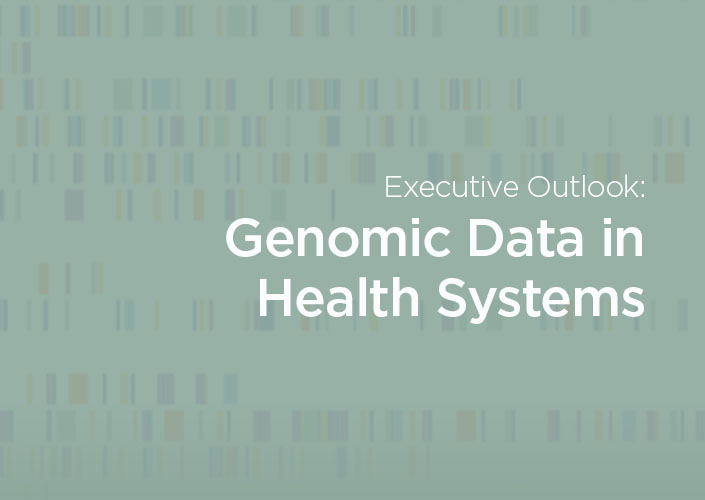Precision medicine is on the horizon and generating excitement, but significant expense and limited reimbursement are challenging mass adoption
The Center for Connected Medicine’s Top of Mind for Top Health Systems 2020 research report sheds light on key technologies set to make an impact as health care industry shifts to value-based care. Precision medicine is one of the report’s focus areas because of its potential to improve patient outcomes.
While precision medicine offers promise for patient care, it also is complex, requiring integration of different data and a cellular understanding of the patient. This complexity can make it difficult for health systems to establish precision medicine programs, which the Top of Mind research points out.
Matthias Kleinz, PhD, Vice President of Translational Programs at UPMC Enterprises, describes precision medicine this way:
“Precision medicine tailors a patients’ treatment based on relevant patient and disease characteristics. Inputs can range from elements of a patients’ history and phenotype to molecular patient or disease characteristics (i.e., biomarkers). Ultimately the goal is to select the right therapy for the right patient at the right time in order to optimize outcomes while reducing the risk of administering ineffective therapies, or worse, treatments with unwanted side effects. The integration of genomics and other molecular biomarkers with real-world patient outcomes data can help identify prognostic and predictive markers that represent a critical starting point for a precision medicine strategy that can streamline clinical care.”
Oncology is the top use case for precision medicine
Approximately one-third of Top of Mind survey respondents said their organization has deployed a precision medicine strategy. Oncology is the predominant use case, with the deepest deployment and adoption. However, a large number of respondents feel it is too early to measure the success of their precision medicine efforts.
The top metrics used to measure precision medicine success and the greatest drivers of precision medicine center on patient care. According to respondents, success is measured by lives saved (59 percent) and enhanced quality of life (52 percent). According to the research, the top drivers of precision medicine programming at health systems are:
- improved patient care/better outcomes (83 percent);
- more personalized care (44 percent);
- clinical researching findings (31 percent);
- enhanced quality of life (31 percent);
- and lives saved (31 percent).
Both drivers and success metrics demonstrate orientation toward the patient; they may also indicate just how faraway precision medicine is from lowering the cost of care for systems with newly-shouldered financial risk. In fact, guaranteed reimbursement and ROI are cited as the overwhelming barriers to adoption, with 51 percent of survey respondents suggesting payment is a problem.
Lack of integration of ‘omic’ data into the EHR is problematic
One breakdown seems to be around electronic health record (EHR) integration. Put another way, this breakdown connects to data and analytics (another topic of the Top of Mind 2020 report). For health systems that haven’t begun precision medicine efforts, or that had difficulty starting programs, EHR integration was identified as a concern. This mirrors a Top of Mind survey question about integrated data sources, which found fewer than a quarter of respondents said genomics data is an integrated data source at their institution.
Harkening back to the definition of precision medicine from Dr. Kleinz (who was not surveyed as part of the Top of Mind research), harnessing data analytics to identify prognostic and predictive factors is critical to lowering cost and achieving population health. Big picture goals can’t be realized if health systems aren’t equipped to manage and maximize important data.
Health systems and academia forge ahead, despite reimbursement challenges
While reimbursement models evolve and systems build capacity to integrate ‘omic’ data with EHR and other info, precision medicine is gaining traction. Health system innovation and venture arms, genomic centers, cell therapy programs, and select departments are all exploring and using cellular therapies to improve care.
For example, in 2019, Brigham and Women’s Hospital opened the Preventative Genomics Clinic, which aims to deliver “preventative genomics for healthy people.” Per its website, services are “typically not covered by health insurance” – a real-life illustration of the reimbursement challenge.
A different approach out of the University of Pittsburgh (Pitt), which recently partnered with Thermo Fisher Scientific to launch the Pharmacogenomics Center of Excellence (PGx) in Pitt’s School of Pharmacy, studies how a person’s genetic makeup may affect their response to a drug. PGx aims to discover and validate medication response predictors in patients and “demonstrate the value of genetic testing to guide medication prescribing in routine clinical practice” – another indication of the ROI/reimbursement challenge in real life.
Precision medicine holds tremendous promise but has a lot to prove. On one side of the equation rests affordability and demand for proven ROI while health care takes heat for ever-climbing costs and waste. On the other, the unprecedented potential to understand prognostic markers in new ways and administer preventative approaches that may make patients healthier, and costs lower.
Download the Top of Mind report for more on precision medicine and the other key technology areas, data aggregation and analytics, and patient engagement.



